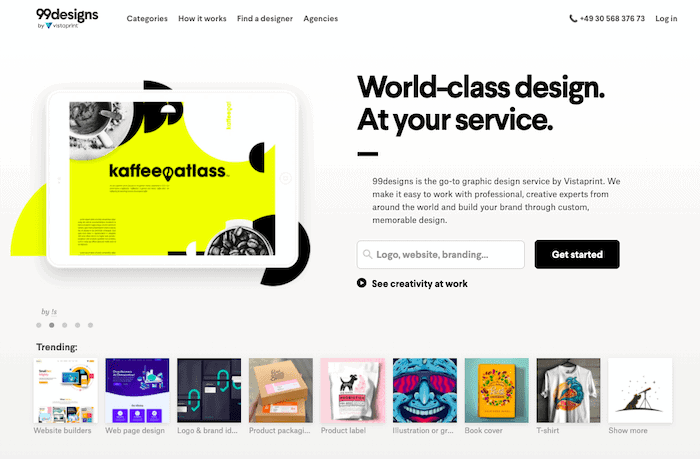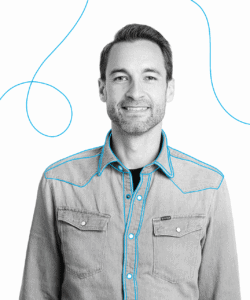Tooltester is supported by readers like yourself. We may earn an affiliate commission when you purchase through our links, which enables us to offer our research for free.
99designs is not your typical freelance designer website. Although you can use it to handpick and hire a designer as with other (web design platforms), what really sets 99designs apart is the fact that you can run a design contest, and choose from dozens of designs to pick a winner.
You start by selecting the type of design you need – whether that’s web design, logos, illustrations, product packaging, or something else. Based on your budget and requirements, you can then choose from four different packages to access a range of designs from entry-to-top-level designers. All this is backed by a 100% money-back guarantee (learn more here), in case you’re not happy with any of the submitted designs.
In this 99designs review, we tested it out with a real-life web design project for a soon-to-be-launched website. As you’ll see, while there were things that we loved (its ease of use and fantastic feedback channels, for example), there were some things we wish we would have known before using it for a more complex design project.
Read our 99designs review below to learn more, and to decide if it’s right for your project.
99designs Overview
Available services:
| Web & app design: | Yes |
| Logo & branding: | Yes |
| Art & illustrations: | Yes |
| Advertising: | Yes |
| Merchandise design: | Yes |
| Web builder services: | Yes |
| Money-Back Guarantee: | Yes |
What are 99designs’ pros?
- The luxury of choice. Contests tend to get dozens, if not hundreds of submissions
- No need to write a lengthy brief – 99designs guides you through this process with a series of questions around your requirements and preferences
- Turnaround times are relatively short – around 7 days till completion for more basic projects
- Excellent feedback channels that let you add comments and even annotations to submitted designs
- Handy features such as polls, in case you’re struggling to pick a winner
What are the disadvantages?
- It’s pricier than other freelance design websites – the most basic design package (e.g. for a banner ad) starts at around $49, while web designs start from $599. Generally speaking, the more you pay, the better the quality of the designs
- The vast majority of submissions is likely to come from upstarting designers who don’t have tons of professional experience
- Reviewing multiple designs ultimately requires more involvement on your part – you’ll be very busy giving feedback while the contest is running!
- For the designers, a lot of the work they put into submitting designs goes uncompensated – which was sometimes reflected in the quality of the designs
- The transparency around designers could be better. We felt there was a lot going on behind the scenes that we just didn’t have visibility into
- You can only communicate with designers via the platform. This might not be ideal for more complex designs projects
The bottom line
It does this by simplifying the briefing process, empowering you with choice, and giving you the tools you need to provide feedback and refine your design to your liking.
It will involve a little more effort in terms of reviewing work and communicating feedback, but this is a small price to pay if you appreciate having a wider range of design options to choose from.
That being said, we don’t think 99designs is suitable for all design projects. While it can handle simple project requests well (e.g. a logo or illustration), more complex, conceptual projects (e.g. branding, web design) probably require a more direct channel of communication with designers.
99designs describes itself as “the world’s largest online graphic design marketplace”. While this was a little hard to verify, it’s true that since it was founded in 2008 in Melbourne, the company has seen some astonishing growth.
Starting life as a series of friendly design contests between online forum participants, the founders of 99designs quickly realized they could monetize this idea by creating an online marketplace of designers. Within 16 months, 99designs had generated $5 million in design contests. By 2016, it had around one million registered designers.
In 2020, 99designs was acquired by Vistaprint’s parent company Cimpress, helping them to gain an even stronger foothold in the online design market.
99designs Pricing: How Does It Work?
With 99designs, you can choose to either run a design contest, or – and not many people know this – hire a designer directly (99designs calls this “1-to-1 projects”). The pricing differs between each approach.
1-to-1 Projects Pricing
The pricing for 1-to-1 projects is largely determined by the designer, although this is negotiable. You can either request a quote based on your project’s requirements and budget, or purchase a designer’s service at a pre-set price. A bit like Fiverr but price-wise, it’s definitely more up-market.
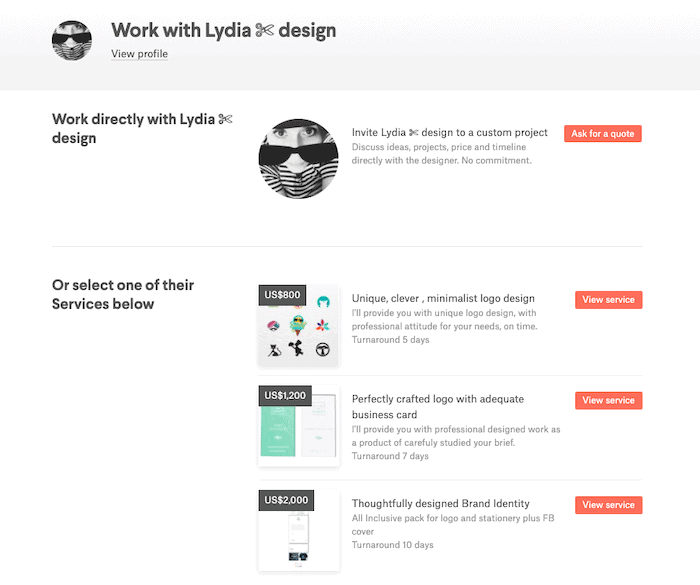
1-to-1 services offered by a designer on 99designs
For 1-to-1 projects, you’ll also be charged a 5% platform fee on top of what you pay for your project to cover customer support, payment processing fees etc.
Contest Pricing
When you run a design contest, you’ll be able to select from four different packages. Here’s a breakdown of the differences between each package:
| Bronze | Silver | Gold | Platinum | |
|---|---|---|---|---|
| Price* | From $49 – $599 | From $79 – $899 | From $129 – $1,599 | From $199 – $2,499 |
| Estimated no. of submissions* | 15+ | 25+ | 35+ | 25+ |
| Designer levels | Open to all levels (Entry, Mid & Top) | Open to all levels (Entry, Mid & Top) | Can restrict to Mid & Top level designers | Can restrict to Top level designers |
| Dedicated Manager | No | No | No | Yes |
| Priority Support | No | No | No | Yes |
* Both the price and the number of submissions will vary depending on the design category. For example, simpler projects such as banner ads are the cheapest, starting at $49 for the Bronze package. As they are relatively low-effort they’re also likely to attract more design submissions (30+ for the Bronze package, 50+ for the Gold package).
Projects that involve more work, such as web design, start at $599 for the Bronze package (with an estimated 15 concepts), and go up to $2,499 for the Platinum project (with around 25 concepts). The contest prizes will be awarded to the winning designer, so the more you pay, the more incentive there is for designers to participate.
You can also set custom pricing, as long as it’s above the value of the Bronze package. The drawback is that even if you’re setting a high prize amount (e.g. higher than the Platinum package), you won’t get any of the benefits of that package (dedicated manager, priority support) – so it’s hard to see the value in doing so.
Note – design contests are paid upfront.
More information:
99designs Review: How We Rated It
Museos.com is the brainchild of Céline Mülich, who is part of our Tooltester family (both figuratively and literally!). Her online guides to Europe’s top museums are currently spread across five different websites. Recently, she decided to merge them all under the Museos.com brand – and for that, she needed a brand-new website design.
Having used 99designs in the past for some logo and illustration designs, Céline decided to use it once again for her new website – and test it out for Tooltester in the process.
So, what was the verdict? Let’s find out…
| Criterion | Rating | Our verdict |
|---|---|---|
| Ease of use | You could see how something as complex as launching an online contest could quickly go sideways – but 99designs manages to avoid this with its straightforward process.
You simply choose your design category (each contest is limited to just one type of design), create the brief, submit your payment details, and launch your contest. Once designs start coming in, it’s easy to provide feedback to get designs closer to your vision (more on that below). |
|
| Briefing process | The briefing process couldn’t be simpler, as 99designs gives you a series of questions to answer to help guide your project requirements. You can also upload imagery that you like, or point to relevant online examples.
For logo and branding-related projects, you also get the chance to select concepts, define color schemes, and specify the kind of style you’re aiming for (e.g. modern vs classic, playful vs sophisticated). |
|
| Services offered | Design services, web builder services | As its name suggests, 99designs does designs – and designs only. It offers pretty much every kind of design work imaginable. The only service that falls slightly out of this category is its web builder service (where a designer helps you create a site using Wix, Squarespace, Jimdo etc). |
| Transparency | Each designer has a profile that you can view, with information on their Designer Level (Entry, Mid or Top), portfolio samples (submissions for other 99design contests), star ratings and reviews (based on completed projects), and stats (no. of contests won, repeat clients, 1-to-1 projects worked on etc).
Contact information isn’t available but you can send designers a private message via their profile. You’ll also be able to see how quick they are at responding to messages/feedback. However, it would be nice to see designers’ locations, and to have more transparency around whether they are truly freelance designers or working for a design agency – which we suspected was our case (and had implications for us towards the end of the project). |
|
| Communication channels | Excellent. Aside from the private messages we just mentioned, you can also message all designers in your contest at once.
Plus, the feedback channels are top-notch. You can rate designs, provide comments, and add annotations / markups to designs. (Note that the annotations feature was slightly buggy and didn’t always work for us, however). You can also decline / reject designs to eliminate them from the contest. |
|
| Level of talent | Designer levels are determined by 99designs’ Designer Curation team. We received 100 submissions in our contest and felt that the quality of designs was generally pretty high – we awarded around half of these 4-5 stars.
We did hit a couple of snags towards the end of the process, however, which made us question the quality of the final designs – more on that later. |
|
| Turnaround time | From 7-11 (or more) days, depending on the category | Contests are broken up into several rounds, and each of these lasts a few days (although more complex projects such as web design run a bit longer). It might also take longer if you need more time selecting finalists and winners, or if you need additional changes to be made during handover.
For simpler projects (e.g. logo designs or illustrations), you can also pay a little extra to fast-track turnaround times – these reduce turnaround time to 1-3 days. |
| Support | Phone support (Mon – Fri), online tickets, help center
|
The Help Center is comprehensive and clear – we found the answers we needed on more than one occasion. We only had to contact the support team once and did it via the ‘Submit a request’ form – their response was quick and we were pleased with how they resolved the issue.
If you need more general help with your contest you can also request a free design consultation, or hire a Personal Creative Consultant for an additional fee (as we didn’t test these, we weren’t quite clear on the difference between them). However, we feel that chat support would be a really useful addition. |
| Refund policy | 99designs offers a 100% money-back guarantee on contests, in case you’re not happy with the designs submitted. There are just a few small exceptions (e.g. for guaranteed prizes, or contests that are in the final round / already have a winner). | |
| Overall rating | 99designs is easy to use and there are plenty of tools to help you provide feedback to get your designs perfect. It’s fantastic for simple projects that might benefit from multiple concepts, but is perhaps not ideal for more complex projects – due to both the limited communication channels, and the level of talent available. |
Our Experience Using 99designs for a Website Redesign Project
Our design contest required participants to create a brand-new homepage design for the Museos.com website. We supplied a logo, font, brand colors and images, and purchased the Silver package.
Here’s a rundown of what happened in each round of the contest:
1. Qualifying round
This first round usually lasts 4 days, but as ours was a web design project, it instead ran a little longer (6 days). We received our first design a day after the contest launched – pretty impressive, considering that this was not your average “design-me-a-logo” kind of project!
The idea of the Qualifying round is to provide feedback to the designer and refine designs. This was easy to do, thanks to the ability to assign star ratings, and 99designs’ commenting and markup features. Unfortunately however, the latter didn’t always work for us – not sure if it was simply a case of the platform having a bad day, or if it’s something that other users frequently experience too.
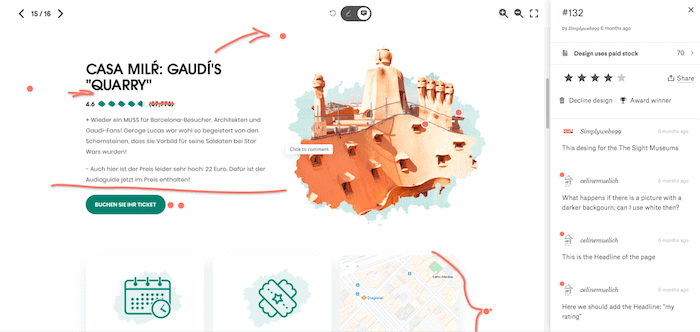
Providing feedback to designers during the Qualifying round
While the Silver package typically receives around 25 design concepts, in the end we got close to 100 designs from around 20 designers – so this was a nice little bonus.
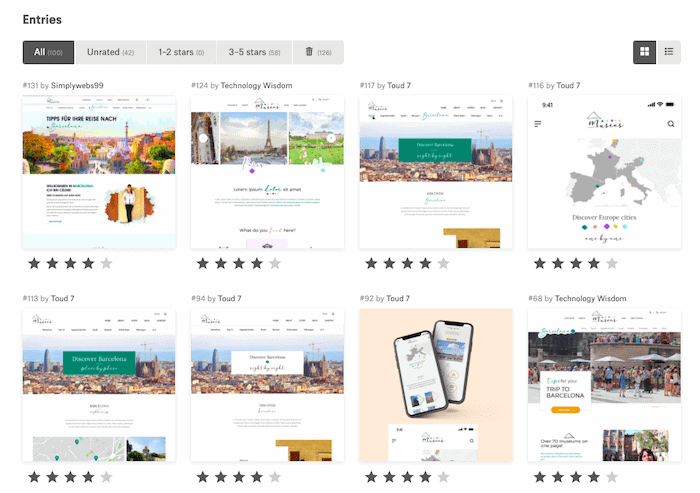
Submissions during the Qualifying round
Over the 6 days, designers continued to work on iterations based on our feedback, right up until the next round of the contest.
Truthfully, this was probably the most intensive, time-consuming (and stressful!) part of the whole process. Knowing we only had 6 days for this round, we wanted to make sure designers got feedback quickly, which meant that we were spending a lot of time checking designs and passing on our changes. It was a lot of work – definitely more than if we had just been working with the one designer.
2. Select finalists and final round
In this round, we had to select up to 6 designers to take into the next and final round. We had up to 4 days to do this.

Contest finalists
This is also the point of the contest where it becomes guaranteed – that is, once you choose your top 6, you will no longer be able to cancel your contest and get the money-back refund.
We then had another 3 days to revise designs, getting them as close to the final product as possible.
3. Award a winner
This round gives you a very generous 14 days to pick a winner (although you can choose a winner straight away). We took advantage of the Polls feature to get the opinions of friends and family, which helped sway us towards a final design.
While there were a few options that we seriously considered, in the end, we picked the following as the winner:
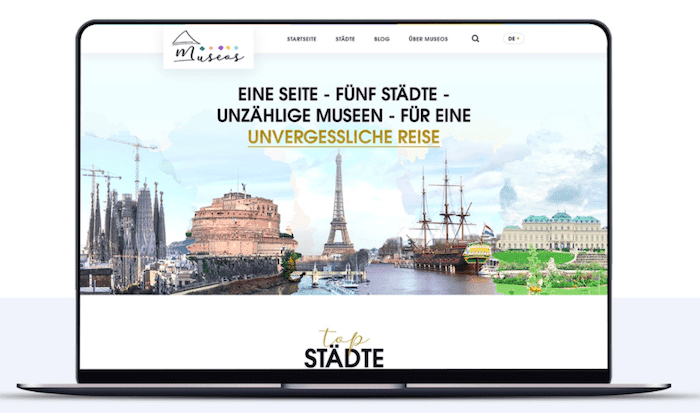
The winning homepage design
Apart from nailing the brief, we also liked the creative touches the designer added (such as the artistic ‘paint’ effect added to the images):
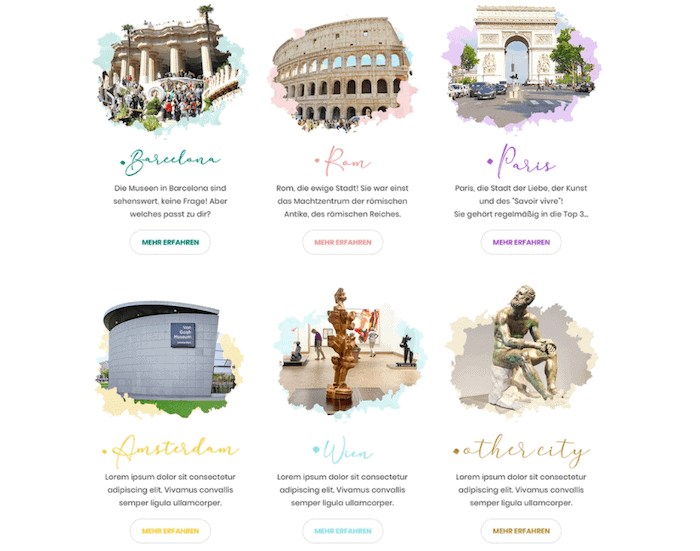
Up until this point it had all been pretty smooth sailing – but in the last stage, we encountered a few hiccups.
4. Handover
Once we had awarded our winner, 99designs gave us 5 days for designs to be finalized and files to be handed over.
Here’s when things started to go south. Not only did our designer start becoming less responsive when we requested changes – we felt the quality of the work started to decline too. They started to make small mistakes, and generally lacked the attention to detail that helped us award them in the first place.
It almost felt like a completely different designer, and we started to suspect that this was maybe the case. This led us to believe that our “designer” was actually an agency employing multiple designers to work on the one project (a more senior one upfront and a more junior one towards the end).
While this was frustrating, it wasn’t exactly a dealbreaker, so we pressed on. However, the implications of this weren’t fully revealed until we passed on the final files to our developer, who told us that the files were lacking a lot of important elements – correct file formats, gridlines, and even standardised font sizes (apparently the designs had 20 different font sizes!).
By this point it was too late to request further changes, and we’d grown a little tired of the constant back and forth with our designer. So, we ended up hiring another designer (outside of the platform), and having them rework the files so that they would be development-ready. Which of course, meant more time and money in the end.
How typical is this of a 99designs project? Well, we’d used 99designs on smaller projects (for logos and illustrations) in the past, and definitely had never experienced this before. In fact, these projects actually helped us find a designer that we still work with today.

A 99designs illustration created for us a few years ago
Based on this latest experience, though, we’d think twice about using 99designs again for bigger, more complex design projects. The strict timing of the contest rounds, single communication channel, and lack of visibility around the designer are perhaps too restrictive for projects that have more technical requirements.
That being said, we were very happy with the quality of designs, so if we were to use 99designs again on a web design project, we’d work with a developer during the design process to ensure that the final files included everything he or she would need.
99designs Review: Conclusion
The idea of running a design contest is great in theory, and 99designs has proven that it can work pretty well in practice too – depending on the kind of design work you need.
We’d have no hesitation in recommending 99designs if all you need is a simple logo design, illustration, banner ad or piece of merchandise. These are the kinds of projects that benefit from having multiple options, and our past experience with this type of work on 99designs has been nothing but positive.
And while we wouldn’t be completely dissuaded from trying it out again for bigger projects, we do recognize that the designers on 99designs are probably more likely to be ‘transactional’ designers rather than your conceptual, big-picture-thinking designers – so it’s something to keep in mind when assessing whether it’s suitable for your project.
> Try 99designs for your project (money-back guarantee)
Have you tried 99designs? What was your experience like? Let us know in the comments below!
THE BEHIND THE SCENES OF THIS BLOG
This article has been written and researched following a precise methodology.
Our methodology